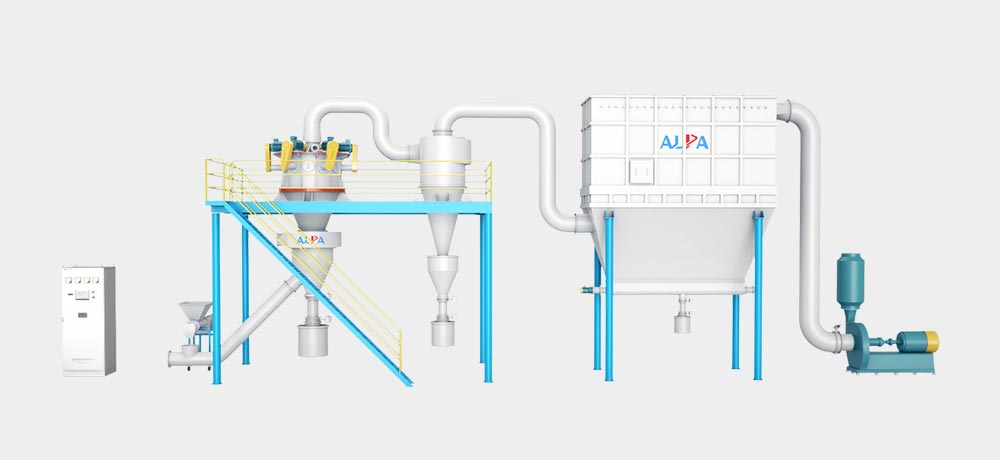Classifier for powder industry
Classification is based on the principle that the solid particles have different sedimentation speeds in the medium due to different particle sizes, and the particle group is divided into two or more particle size levels. Classification is an indispensable part of the crushing process, and the broad classification includes sieving.
Comparison of sieving and classification
| Sieving | Grade | |
| Same point | The properties are the same, both of which divide the populations with a wide particle size range into products with a narrow particle size range | |
| working principle | Separated more strictly according to geometric dimensions | According to the difference of the sedimentation speed, the density has an influence on the classification according to the particle size |
| Product Features | Among the products of the same grade, the particle size is relatively uniform | Products of the same grade have a wide range of particle size and unclear boundaries, mainly with different densities. |
| Work efficiency | The sorting efficiency of fine-grained materials is low | High efficiency in processing materials |
| Scope of application | Suitable for materials >2-3mm | Suitable for materials <2-3mm |
The commonly used fluid media for classification are water (called wet classification or hydraulic classification) and air (called dry classification or wind classification). The classifier system consists of air classifier, cyclone separator, dust collector, induced draft fan, electric control cabinet, etc.

Horizontal multi-rotor classifier system layout diagram
Dry classification equipment
- Gravity Air Classifier
The classification is carried out by using the different sedimentation speed and movement trajectory of the particles in the gravity and air medium resistance. Its structure is simple, the pressure drop is small, the processing capacity is large, but the classification accuracy is poor.
Gravity air classifiers include vertical flow type gravity classifiers, horizontal flow type gravity classifiers, and special flow type gravity classifiers.
- Inertial air classifier
Inertia is an inherent property of matter and is determined by mass. During the movement, when particles are subjected to a force that changes the direction of their movement, different inertias will form different trajectories to achieve classification. Its structure is simple, there are no moving parts inside, and the classification accuracy is high, but the output is low.
Inertial air classifiers include jet-type inertial classifiers, jet-type inertial classifiers, and other types of inertial classifiers.
- Centrifugal Force Air Classifier
The classification is achieved under the combined action of air resistance, gravity and centrifugal force, with high classification accuracy and large processing capacity.
Centrifugal classifiers include free vortex type centrifugal classifiers, quasi-free vortex type centrifugal classifiers, forced vortex type centrifugal classifiers, forced vortex type centrifugal classifiers include traditional fan blade type forced vortex centrifugal classifiers, cage rotor type forced vortex centrifugal classifiers Classifiers, rotary wall forced vortex centrifugal classifiers, other types of forced vortex centrifugal classifiers.
- Combined classifier
It is a combination design of the previous models, which can often integrate multiple advantages. It is the main method of setting the classifier before a new breakthrough in classification theory has been achieved.
Wet classification equipment
Equipment that uses gravity or centrifugal force to classify materials according to the sedimentation law of particles in the fluid, such as spiral classifiers, hydrocyclones, cone classifiers and trough classifiers, etc.; control the size of the screen holes and classify materials according to the particle size The equipment, such as vibrating screen, curved screen and fine screen, etc.
The role of classification
The qualified products of grinding can be separated in time to avoid over-grinding, and at the same time, unqualified coarse sand can be separated and returned to grinding. This can well guarantee the sorting effect and effectively improve the grinding efficiency.
Application of classifier
All kinds of powders are super finely graded, remove impurities, and break up; classification of coarse particles entrained by ultra-fine powder and nano powder; classification of materials with strong viscosity, agglomeration, difficult to disperse, and poor fluidity; quartz, ceramics, refractory materials, zirconium Classification of superhard materials such as British sand and silicon carbide.
The function of the fine grading equipment is to ensure that the particle size distribution of the product meets the needs of the application, and to improve the efficiency of the ultra-fine grinding operation.
According to the classification medium, fine classifiers can be divided into dry classifiers with air as the medium (mainly rotor (turbine) airflow classifiers) and wet classifiers with water as the medium (ultrafine hydrocyclones, horizontal Type screw centrifuge, sedimentation centrifuge, etc.).
The development trend of fine classification equipment is fine particle size, high precision, high efficiency, large processing capacity, low energy consumption per unit product, and low wear.
Article source: China Powder Network
